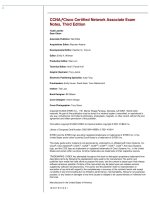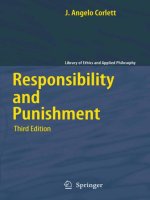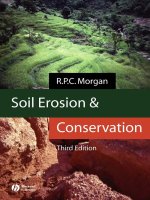SOIL EROSION AND CONSERVATION THIRD EDITION docx
Bạn đang xem bản rút gọn của tài liệu. Xem và tải ngay bản đầy đủ của tài liệu tại đây (3.72 MB, 316 trang )
SOIL EROSION AND CONSERVATION
MSEPR 11/19/04 02:49 PM Page i
THIRD EDITION
R. P. C. Morgan
National Soil Resources Institute,
Cranfield University
SOIL EROSION AND
CONSERVATION
MSEPR 11/19/04 02:49 PM Page iii
© 2005 by Blackwell Science Ltd
a Blackwell Publishing company
BLACKWELL PUBLISHING
350 Main Street, Malden, MA 02148-5020, USA
108 Cowley Road, Oxford OX4 1JF, UK
550 Swanston Street, Carlton, Victoria 3053, Australia
The right of R. P. C. Morgan to be identified as the Author of this Work has been asserted in accordance
with the UK Copyright, Designs, and Patents Act 1988.
All rights reserved. No part of this publication may be reproduced, stored in a retrieval system, or
transmitted, in any form or by any means, electronic, mechanical, photocopying, recording or otherwise,
except as permitted by the UK Copyright, Designs, and Patents Act 1988, without the prior permission of
the publisher.
First published 1986 Longman Group Limited
Second edition 1995
Third edition published 2005 by Blackwell Publishing Ltd
Library of Congress Cataloging-in-Publication Data
Morgan, R. P. C. (Royston Philip Charles), 1942–
Soil erosion and conservation / R. P. C. Morgan. – 3rd ed.
p. cm.
Includes bibliographical references and index.
ISBN 1-4051-1781-8 (pbk. : alk. paper)
1. Soil erosion. 2. Soil conservation. I. Title.
S623.M68 2005
631.4¢5 – dc22
2004009787
A catalogue record for this title is available from the British Library.
Set in 9 on 11
1
/
2
pt Minion
by SNP Best-set Typesetter Ltd., Hong Kong
Printed and bound in the United Kingdom
by MPG Books Ltd, Bodmin, Cornwall
The publisher’s policy is to use permanent paper from mills that operate a sustainable forestry policy, and
which has been manufactured from pulp processed using acid-free and elementary chlorine-free practices.
Furthermore, the publisher ensures that the text paper and cover board used have met acceptable
environmental accreditation standards.
For further information on
Blackwell Publishing, visit our website:
www.blackwellpublishing.com
MSEPR 11/19/04 02:49 PM Page iv
Contents
v
Foreword vii
Preface ix
1 Soil erosion: the global context 1
Box 1. Erosion, population and food supply 9
2 Processes and mechanics of erosion 11
Box 2. Initiation of soil particle movement 42
3 Factors influencing erosion 45
Box 3. Scale and erosion processes 65
4 Erosion hazard assessment 67
Box 4. Upscaling detailed field surveys to national surveys 93
5 Measurement of soil erosion 95
Box 5. Sediment budgets 113
6 Modelling soil erosion 116
Box 6. Uncertainty in model predictions 149
7 Strategies for erosion control 152
Box 7. Planning a soil conservation strategy 172
8 Crop and vegetation management 175
Box 8. Selecting vegetation for erosion control 197
9 Soil management 200
Box 9. Tillage erosion 210
10 Mechanical methods of erosion control 212
Box 10. Laying out terraces and waterways 241
Contents
MSEPR 11/19/04 02:49 PM Page v
11 Implementation 244
Box 11. Land Care 254
12 The way ahead 257
References 262
Acknowledgements 297
Index 299
Contents
vi
MSEPR 11/19/04 02:49 PM Page vi
Foreword
vii
Soil erosion has been an environmental concern in such countries as China and those bordering
the Mediterranean Sea for millennia. In the United States the major impetus to scientific research
on soil erosion and conservation came from Hugh Hammond Bennett, who led the soil conser-
vation movement in the 1920s and 1930s. In Western Europe there was growing realization from
the 1970s that soil erosion could have a major effect on soils, even on lowland arable areas. More
recently the topic has come on to the political agenda with the Commission of the European
Communities developing a thematic strategy for soil protection. Integral to this is the recogni-
tion that soils perform a range of key functions, including the production of food, the storage of
organic matter, water and nutrients, the provision of a habitat for a huge variety of organisms
and preserving a record of past human activity. Any degradation in the quality of the soil resource
through erosion can have an impact on the ability of soils to perform this range of functions. In
the twentieth century and earlier, the main practical concern about soil erosion was with refer-
ence to impacts on food production. This is still the case in many parts of the world, but now the
more frequent concerns relate to the reduction in soil carbon, the movement of nitrogen and the
removal of phosphorus in soluble and particulate forms. There are also concerns about the effects
of erosion on landscape quality as well as on cultural records. As an example, many archaeolo-
gists are concerned about the effects of soil surface lowering through erosion and the conse-
quential impacts of deeper ploughing on archaeological features. The publication of this third
edition of Roy Morgan’s book Soil Erosion and Conservation is thus very timely and reflects the
wider concerns regarding the issue. The book is also permeated with Roy Morgan’s own exten-
sive and international experience in soil erosion research.
A key theme of this book is that a soil conservation strategy must evolve from detailed know-
ledge and understanding of actual erosional processes. Thus Chapters 2 to 6 deal with the
processes of soil erosion, the assessment of erosion risk at different scales and the monitoring and
modelling of erosion. The treatment of modelling in Chapter 6 is particularly comprehensive
through discussion of empirical and physically based models, sensitivity analysis and model vali-
dation. The inclusion of many worked examples is of great assistance to the reader. The remain-
ing chapters focus on conservation strategies with emphases on crop and vegetation management,
soil management and mechanical methods of erosion control. A section dealing with tillage
erosion reflects recent research that indicates the potential magnitude of this process. In Chapter
11 Roy Morgan argues that the successful implementation of soil conservation measures is only
possible through a combination of scientific, socio-economic and political considerations, exem-
plified by the highly successful and integrated approach of the Australian Land Care Programme.
Foreword
MSEPR 11/19/04 02:49 PM Page vii
He argues in the concluding chapter that the weakest part of soil conservation programmes has
been the lack of effective legal frameworks. This will only be remedied if there is wider appre-
ciation of soil erosion processes and the need for management. This book makes a major contri-
bution to achieving that objective.
Donald A. Davidson
Foreword
viii
MSEPR 11/19/04 02:49 PM Page viii
Preface
ix
Soil erosion is a hazard traditionally associated with agriculture in tropical and semi-arid areas
and is important for its long-term effects on soil productivity and sustainable agriculture. It is,
however, a problem of wider significance occurring additionally on land devoted to forestry, trans-
port and recreation. Erosion also leads to environmental damage through sedimentation, pollu-
tion and increased flooding. The costs associated with the movement and deposition of sediment
in the landscape frequently outweigh those arising from the long-term loss of soil in eroding fields.
Major problems can result from quite moderate and frequent erosion events in both temperate
and tropical climates. Erosion control is a necessity in almost every country of the world under
virtually every type of land use. Further, eroded soils may lose 75–80 per cent of their carbon
content, with consequent emission of carbon to the atmosphere. Erosion control has the poten-
tial to sequester carbon as well as restoring degraded soils and improving water quality.
Since the second edition of Soil Erosion and Conservation was published in 1995, soil erosion
has assumed even greater importance because of the higher priority now being given to the envi-
ronmental issues associated with sediment. This revised edition recognizes more strongly that
erosion is not just an agricultural problem and that loss of soil from construction sites, road banks
and pipeline corridors can also result in unwanted and costly downstream damage, as well as hin-
dering attempts at land restoration. Nevertheless, rather than these issues and environmental pro-
tection being discussed in detail, the decision has been taken to maintain the philosophy of the
original book, namely to provide a text that covers soil conservation from a substantive treatment
of erosion. A thorough understanding of the processes of erosion and their controlling factors is
a prerequisite for designing erosion control measures on a sound scientific basis wherever they
are needed. The aim of producing a text with a global perspective on research and practice is also
retained.
The text follows the structure of previous editions but substantial changes have been made to
some chapters and minor revisions to the others. Following major advances in research over the
past ten years, new material is included on the importance of tillage in moving soil over the land-
scape, the use of terrain analysis in erosion risk assessment, the use of tracers in erosion mea-
surement, the validation of erosion models and problems of uncertainty in their output, defining
soil loss tolerance by performance-related criteria, traditional soil conservation measures, incen-
tives for soil conservation and community approaches to land care. The sections on gully erosion,
the mechanics of wind erosion, the dynamic nature of soil erodibility, the effects of vegetation on
wind erosion and mass movement, economic evaluation of erosion control, the use of geotextiles
and the use of legislative instruments in promoting soil conservation have been substantially
Preface
MSEPR 11/19/04 02:49 PM Page ix
rewritten. Updates have been made throughout the text. In line with the comments of reviewers
of the previous edition, the chapter on measurement is now placed before the chapter on mod-
elling. In the revised text, this is certainly a more logical order. In addition, selected topics have
been removed from the main text of each chapter and placed in a box at the end. The topics are
either of generic background interest or relate to specific material that is best treated in a discrete
way.
Not surprisingly, in order to keep the text at a reasonable length and reasonable price, some
material has had to be omitted. By trying to restrict omissions to material that is no longer rele-
vant, either because scientific understanding has improved or because it is not mainstream to
erosion control in practice, it is hoped that nothing vital has been lost. Reference to seminal work
of the 1940s to 1970s has been retained, partly to give an important historical context but also to
maintain an awareness of what has been achieved in the past so as to discourage others from
attempting unnecessary repetition.
The text remains based on courses given on the Silsoe campus of Cranfield University and,
again, contains material from research and advisory work carried out by myself, my colleagues
and students. As before, the contributions of the last two groups are much appreciated. The text
is intended for undergraduate and postgraduate students studying soil erosion and conservation
as part of their courses in geography, environmental science, agriculture, agricultural engineer-
ing, hydrology, soil science, ecology and civil engineering. In addition, it provides an introduc-
tion to the subject for those working on soil erosion and conservation, either as consultants and
advisers or at research and experimental stations.
I am grateful to two anonymous reviewers for their constructive comments on an earlier draft
of the manuscript. My thanks also go to students and staff at Silsoe for encouraging me to produce
a new edition and to Gillian, Richard and Gerald for their support.
R. P. C. Morgan
Silsoe
Preface
x
MSEPR 11/19/04 02:49 PM Page x
Soil erosion costs the US economy between US$30 billion (Uri & Lewis 1998) and US$44 billion
(Pimental et al. 1993) annually. The annual cost in the UK is estimated at £90 million (Environ-
ment Agency 2002). In Indonesia, the cost is US$400 million per year in Java alone (Magrath &
Arens 1989). These costs result from the effects of erosion both on- and off-site.
On-site effects are particularly important on agricultural land where the redistribution of soil
within a field, the loss of soil from a field, the breakdown of soil structure and the decline in
organic matter and nutrient result in a reduction of cultivable soil depth and a decline in soil fer-
tility. Erosion also reduces available soil moisture, resulting in more drought-prone conditions.
The net effect is a loss of productivity, which restricts what can be grown and results in increased
expenditure on fertilizers to maintain yields. If fertilizers were used to compensate for loss of fer-
tility arising from erosion in Zimbabwe, the cost would be equivalent to US$1500 million per year
(Stocking 1986), a substantial hidden cost to that country’s economy. The loss of soil fertility
through erosion ultimately leads to the abandonment of land, with consequences for food pro-
duction and food security and a substantial decline in land value.
Off-site problems arise from sedimentation downstream or downwind, which reduces the
capacity of rivers and drainage ditches, enhances the risk of flooding, blocks irrigation canals and
shortens the design life of reservoirs. Many hydroelectricity and irrigation projects have been
ruined as a consequence of erosion. Sediment is also a pollutant in its own right and, through the
chemicals adsorbed to it, can increase the levels of nitrogen and phosphorus in water bodies and
result in eutrophication. Erosion leads to the breakdown of soil aggregates and clods into their
primary particles of clay, silt and sand. Through this process, the carbon that is held within the
clays and the soil organic content is released into the atmosphere as CO
2
. Lal (1995) has estimated
that global soil erosion releases 1.14Pg C annually to the atmosphere, of which some 15Tg C is
derived from the USA. Erosion is therefore a contributor to climatic change, since increasing the
carbon dioxide content of the atmosphere enhances the greenhouse effect.
The on-site costs of erosion are necessarily borne by the farmer, although they may be
passed on in part to the community in terms of higher food prices as yields decline or land
goes out of production. The farmer bears little of the off-site costs, which fall on local authori-
ties for road clearance and maintenance, insurance companies and all the land holders in the
local community affected by sedimentation and flooding. Off-site costs can be considerable.
Erosive runoff from arable land in four catchments in the South Downs, England, in October
1987 caused damage equivalent to £660,000 (Robinson & Blackman 1990). Sedimentation ponds
to trap sediment and runoff generated from arable land in an area of 5516 km
2
in central Belgium
Soil erosion: the global context
1
CHAPTER 1
Soil erosion: the
global context
MSE1 11/19/04 02:28 PM Page 1
cost €38 million to construct and €1.5 million annually to maintain (Verstraeten & Poesen
1999).
Although soil erosion is a physical process with considerable variation globally in its severity
and frequency, where and when erosion occurs is also strongly influenced by social, economic,
political and institutional factors. Conventional wisdom favours explaining erosion as a response
to increasing pressure on land brought about by a growing world population and the abandon-
ment of large areas of formerly productive land as a result of erosion, salinization or alkaliniza-
tion. In the loess plateau region of China, for example, annual soil loss has increased exponentially
since about 220 in a simple relationship with total population (Wen 1993). Population pres-
sure forces people to farm more marginal land, often unwisely, especially in the Himalaya, the
Andes and many mountainous areas of the humid tropics. In other parts of the world, however,
erosion can be seen as a direct response to abandonment of the land associated with rural depop-
ulation. A dramatic example comes from the terraced mountain slopes of the Haraz in Yemen,
where land abandonment occurred following droughts in the 1900s, the 1940s and between 1967
and 1973, and then increased markedly in the 1970s as people migrated to Saudi Arabia and the
Gulf States. With fewer people on the land, terrace walls were allowed to collapse and erosion is
now reducing the depth of the already shallow soil by 1–3cm yr
-1
(Vogel 1990). In much of
Mediterranean Europe, policies to reduce the number of people employed in agriculture and to
increase farm size and the level of mechanization have had a twofold effect. First, traditional
terrace structures are left to decay. Second, the increase in farm size is often accompanied by
large-scale earth moving and land levelling, which makes the soil more erodible. Almost every-
where that land consolidation programmes have been carried out, rates of soil erosion have
increased.
The prevention of soil erosion, which means reducing the rate of soil loss to approximately
that which would occur under natural conditions, relies on selecting appropriate strategies for
soil conservation, and this, in turn, requires a thorough understanding of the processes of erosion.
The factors that influence the rate of erosion may be considered under three headings: energy,
resistance and protection. The energy group includes the potential ability of rainfall, runoff and
wind to cause erosion. This ability is termed erosivity. Also included are those factors that directly
affect the power of the erosive agents, such as the reduction in the length of runoff or wind blow
through the construction of terraces and wind breaks respectively. Fundamental to the resistance
group is the erodibility of the soil, which depends upon its mechanical and chemical properties.
Factors that encourage the infiltration of water into the soil and thereby reduce runoff decrease
erodibility, while any activity that pulverizes the soil increases it. Thus cultivation may decrease
the erodibility of clay soils but increase that of sandy soils. The protection group focuses on factors
relating to the plant cover. By intercepting rainfall and reducing the velocity of runoff and wind,
plant cover can protect the soil from erosion. Different plant cover affords different degrees of
protection, so that human influence, by determining land use, can control the rate of erosion to
a considerable degree.
The rate of soil loss is normally expressed in units of mass or volume per unit area per unit
of time. Under natural conditions, annual rates are of the order of 0.0045t ha
-1
for areas of mod-
erate relief and 0.45 tha
-1
for steep relief. For comparison, rates from agricultural land are in the
range of 45–450 t ha
-1
(Young 1969). These differences have encouraged many researchers and
practitioners to distinguish between ‘natural’ and ‘accelerated’ erosion, the latter being the result
of human impact on the landscape. In practice, such a distinction is often unhelpful because it
leads to a view that all unacceptably high rates of erosion must be accelerated, whereas the rates
are actually dependent on local conditions. So-called accelerated rates of erosion in lowland
England may, in fact, be an order of magnitude lower than the natural rates recorded in the
Chapter 1
2
MSE1 11/19/04 02:28 PM Page 2
Himalaya, Karakoram or Andes. Theoretically, whether or not a rate of soil loss is severe may be
judged relative to the rate of soil formation. If soil properties such as nutrient status, texture and
thickness remain unchanged through time, it can usually be assumed that the rate of erosion
balances the rate of soil formation. More practically,severity is better judged in relation to the
damage caused and the costs of its amelioration.
Soil erosion: the global context
3
1.1
Spatial variations
On a world scale, investigations of the relationship between soil loss and climate show that at
annual precipitation totals below 450mm, erosion increases as precipitation increases (Walling &
Kleo 1979). But as precipitation increases so does the vegetation cover, resulting in better pro-
tection of the soil surface, so that for annual precipitation between 450 and 650mm, soil loss
decreases as precipitation increases. However, as seen in Fig. 1.1, further increases in precipita-
tion are sufficient to overcome the protective effect and erosion then increases until, again, the
vegetation responds by becoming sufficiently dense to provide additional protection, causing
erosion to decrease. Above 1700mm, the volume and intensity of the rain outweigh the protec-
tive effect of the vegetation and erosion increases with precipitation.
It should be stressed that the general trends described above are often masked by the high vari-
ability in erosion rates for any given quantity of precipitation as a result of differences in soil,
slopes and land cover (Table 1.1). However, if the rates are grouped into categories of natural veg-
etation, cultivated land and bare soil, each group follows a broadly similar pattern, with the highest
rates associated with semi-arid, semi-humid and tropical monsoon conditions. One exception to
this is the humid tropics. Measurements of soil loss from hillslopes in West Africa (Roose 1971),
ranging in steepness from 0.3 to 4°, yield mean annual rates of 0.15, 0.20 and 0.03t ha
-1
under
natural conditions of open savanna grassland, dense savanna grassland and tropical rain forest
respectively. Clearance of the land for agriculture increases the rates to 8, 26 and 90 tha
-1
,while
0 500 1000 1500 2000 2500 3000 3500 4000
0
100
200
300
400
500
600
700
800
900
1000
1100
1200
1300
Mean annual precipitation (mm)
Mean annual sediment yield (t km
–2
yr
–1
)
Fig. 1.1 Relationship between sediment yield and mean annual precipitation (after Walling & Kleo 1979).
MSE1 11/19/04 02:28 PM Page 3
leaving the land as bare soil produces rates of 20, 30 and 170tha
-1
respectively. Thus, removal of
the rain forest results in much greater rises in erosion rates than does removal of the savanna
grassland. These measurements emphasize the high degree of protection afforded by the rain
forest but also reflect the erosive capacity of the high rainfalls in the humid tropics when that
protection is destroyed. The rates of removal of tropical rain forests over the past twenty years
are therefore of major concern with respect to present and future erosion problems.
Many attempts have been made to produce maps of erosion at a global scale. Since some
70 per cent of the sediment delivered by the river systems to the oceans each year is carried
in suspension, these maps are based largely on measurements of suspended sediment yields,
with extrapolations to provide estimates in areas of sparse data. The results are subject to errors
associated with inadequate extrapolation procedures, the different methods used to sample
the sediment and process the data and differences between the river basins in their degree of
human impact. In addition, suspended sediment yield is strongly influenced by the size of the
catchment because of the greater opportunity for sediment to be deposited with increasing
distance of transport and therefore with basin size. Thus a map based on data for drainage
basins of 1000km
2
in size would be very different from one based on data for basins of
10,000km
2
. Figure 1.2 shows the global pattern of suspended sediment yield for catchments
between 1000 and 10,000km
2
in area (Walling & Webb 1983). More recent assessments (Lvovich
et al. 1991; Dedkov & Mozzherin 1996) have served to confirm this pattern, emphasizing the
vulnerability to erosion of the semi-arid and semi-humid areas of the world, especially in China,
India, the western USA, central Asia and the Mediterranean. The problem of soil erosion in these
areas is compounded by the need for water conservation and the ecological sensitivity of the envi-
ronment, so that removal of the vegetation cover for cropping or grazing results in rapid declines
in the organic content of the soil, followed by soil exhaustion and the risk of desertification. Other
areas of high erosion rates include mountainous terrain, such as much of the Andes, the Himalaya
and the Karakoram, parts of the Rocky Mountains and the African Rift Valley; and areas of vol-
canic soils, such as Java, the South Island of New Zealand, Papua New Guinea and parts of Central
America.
A further area of high erosion risk, not discernible from Fig. 1.2, occurs where the landforms
and associated soils are relics of a previous climate. Over much of southern Africa, stratigraphi-
Chapter 1
4
Table 1.1 Annual rates of erosion in selected countries (t ha
-1
)
Natural Cultivated Bare soil
China 0.1–2 150–200 280–360
USA 0.03–3 5–170 4–9
Australia 0.0–64 0.1–150 44–87
Ivory Coast 0.03–0.2 0.1–90 10–750
Nigeria 0.5–1 0.1–35 3–150
India 0.5–5 0.3–40 10–185
Ethiopia 1–5 8–42 5–70
Belgium 0.1–0.5 3–30 7–82
UK 0.1–0.5 0.1–20 10–200
Sources: Browning et al. (1948), Roose (1971), Fournier (1972),
Lal (1976), Bollinne (1978), Jiang et al. (1981), Singh et al.
(1981), Morgan (1985a), Boardman (1990), Edwards (1993),
Hurni (1993).
MSE1 11/19/04 02:28 PM Page 4
cal evidence shows sequences of periods of comparative stability in the landscape, indicated by
the development of humic layers and stone lines, and periods of instability, represented by col-
luvial sediments, often up to 5m thick. Throughout much of Swaziland and Zimbabwe, present-
day gully erosion is particularly severe on these colluvial deposits, which are often fine sandy or
silty in nature and, therefore, inherently highly erodible (Shakesby & Whitlow 1991). Gullying is
also extensive worldwide in areas of deeply weathered regoliths or saprolite, overlying granites
and granodiorites. The deep weathered mantle was probably formed during a more humid tropi-
cal climate when the surface was protected from erosion by a dense vegetation cover. Clearance
of the vegetation has led to an increase in runoff and erosion. Once the upper soil layers have
been removed, the underlying, highly weathered, often very fine substrate is exposed. This offers
limited resistance and rapidly becomes deeply dissected (Scholten 1997). Such conditions occur
not only in southern Africa but also on the margins of the savanna lands in West Africa, Brazil
and southern China.
Within relatively small areas, rainfall characteristics are reasonably uniform and erosion varies
spatially in relation to soils, slopes and land use. Boardman (1990) found that between 1982 and
1987 in the area between Brighton and Lewes in the South Downs, England, most erosion
occurred in fields on the sides of major dry valleys where the relief was greater than 100m and
the land was under winter cereals. Not all the sediment eroded from hillslopes finds its way into
the river system. Some of it is deposited on footslopes and in flood plains, where it remains in
temporary storage, sometimes until the next storm, or, at other times, as in the case of much col-
luvial and alluvial material, for millions of years. Larger drainage basins tend to have a larger pro-
portion of these sediment sinks, which explains why erosion rates expressed per unit area are
generally higher in small basins and decrease as the catchment becomes bigger. The proportion
of the sediment eroded from the land surface that discharges into the river is known as the
Soil erosion: the global context
5
Mean annual
sediment yield
>250
t km
–2
<50 t km
–2
Deserts and ice cap
50–250
t km
–2
Fig. 1.2 A tentative map of global variations in suspended sediment yield (after Walling & Webb 1983).
MSE1 11/19/04 02:28 PM Page 5
Chapter 1
6
1.2
Temporal variations
Typically, data on erosion rates for individual events or years for given locations show a highly
skewed distribution (Fig. 1.3), with a large number of very low magnitude events producing mod-
erate amounts of soil loss and a small number of higher magnitude events. Over a long period
of time, most erosion takes place during events of moderate frequency and magnitude simply
because extreme or catastrophic events are too infrequent to contribute appreciably to the quan-
tity of soil eroded. Experimental studies by Roose (1967) in Senegal showed that, between 1959
and 1963, 68 per cent of the soil loss took place in rain storms of 15–60mm, events that occur
about ten times a year. Studies in mid-Bedfordshire, England (Morgan et al. 1986) indicated that,
in the period 1973–9, 80 per cent of the erosion occurred in 13 storms, the greatest soil loss, com-
prising 21 per cent of the erosion, resulting from a storm of 57.2 mm. These storms have a fre-
quency of between two and four times a year. In contrast, Hudson (1981) emphasized the role of
sediment delivery ratio. Research has shown that this can vary from about 3 to 90 per cent,
decreasing with greater basin area and lower average slope (Walling 1983).
0
2
4
6
8
10
12
14
16
18
20
22
24
020406080100 120 140 160 180 200 220 240 260
Frequency
Erosion rate (m
3
ha
–1
)
Fig. 1.3 Typical frequency distribution of annual erosion rates based on measurements at 270 field sites on
arable land in England and Wales (after McHugh personal communication).
MSE1 11/19/04 02:28 PM Page 6
the more dramatic event. Quoting from research in Zimbabwe, he stated that 50 per cent of the
annual soil loss occurs in only two storms and that, in one year, 75 per cent of the erosion took
place in ten minutes. Moderate events also account for most of the erosion carried out by wind.
Studies on coastal dunes at Cape Moreton, New South Wales, showed that most sand transport
occurred in strong winds of about 14 m s
-1
,with relatively little in winds of gale force and
above because their greater competence was compensated for by their rarity (Chapman 1990).
The frequency of the dominant erosion event may vary for different erosion processes. For
example, for shallow debris slides and mudflows on cultivated fields and grassland in the Mgeta
area of Tanzania the dominant event has a return period of once in five years (Temple & Rapp
1972).
The more dramatic events may become important where erosion is not a function of climate
alone but depends on the frequency at which potentially erosive events coincide with ground con-
ditions that favour erosion. Analysis of 28 years of data for nine small catchments under a four-
year rotation of maize–wheat–grass–grass at Coshocton, Ohio (Edwards & Owens 1991) showed
that the three largest storms, all with return periods of 100 years or more, accounted for 52 per
cent of the erosion and that 92 per cent of the soil loss occurred in the years when the land was
under maize. Extreme events may also produce landscape features that are both dramatic and
long lasting. A slow-moving equatorial storm deposited 631 mm of rain on 28 December 1926
and 1194mm between 26 and 29 December in the Kuantan area of Malaysia, resulting in exten-
sive gully erosion and numerous landslides. The scars produced in the landscape were still visible
35 years later (Nossin 1964).
In addition to the variations in erosion associated with the frequency and magnitude of single
storms, rates of erosion often follow a seasonal pattern. This is best illustrated with reference to
a rainfall regime with a wet and dry season (Fig. 1.4). The vegetation growth follows a similar
pattern but peaks later than the rainfall. The most vulnerable time for erosion is the early part of
the wet season when the rainfall is high but the vegetation has not grown sufficiently to protect
the soil. Thus the erosion peak precedes the rainfall peak.
Somewhat more complex seasonal patterns occur with less simple rainfall regimes or where
the land is used for arable farming. Generally, the period between ploughing and the growth of
the crop beyond the seedling stage contains an erosion risk if it coincides with heavy rainfall or
strong winds. Thus, in western Europe, the period in spring before the crop cover reaches 20 per
cent is often a peak time for erosion when rainfall degrades the bare soil surface, causing the devel-
opment of a surface seal (Cerdan et al. 2002a).
Longer-term spatial variations in erosion occur in relation to changes in land cover. A typical
sequence of events is described by Wolman (1967) for Maryland, where soil erosion rates
increased with the conversion of woodland to cropland after 1700 (Fig. 1.5). They declined as
the urban fringe extended across the area in the 1950s and the land reverted to scrub when the
farmers sold out to speculators, before accelerating rapidly, reaching annual rates of 7000tha
-1
,
when the area was laid bare during housing construction. With the completion of urban devel-
opment, runoff from concrete surfaces is concentrated into gutters and sewers, and annual soil
loss falls below 4t ha
-1
.
Based on stratigraphical and archaeological evidence of valley floor deposits and archival
material, Bork (1989) reconstructed the history of soil erosion in Niedersachsen, Germany. From
the early Holocene, when soils developed under the natural woodlands, up to the early Middle
Ages, erosion rates were extremely low. With the clearance of forest for agriculture between
940 and 1340, erosion increased and reached annual rates of about 10 tha
-1
. Between 1340
and 1350, annual erosion rates rose dramatically to 2250tha
-1
as a result of gully erosion in-
duced by extreme climatic events such as that on 21 July 1342, when the largest flood ever
Soil erosion: the global context
7
MSE1 11/19/04 02:28 PM Page 7
(a)
0
(b)
0
(c)
0
JFM MJ JAS NDOA
Months
Monthly rainfall
and intensity
Monthly vegetation
Monthly erosion
Fig. 1.4 Seasonal cycles of rainfall, vegetation cover and erosion in a semi-humid climate (after Kirkby
1980a).
1000
500
0
1800 1900 20001860 1960
Land use Forest Cropping UrbanWoods and
grazing
Construction
Sediment yield (t km
–2
)
Fig. 1.5 Relationship between sediment yield and changing land use in the Piedmont region of Maryland,
USA (after Wolman 1967).
MSE1 11/19/04 02:28 PM Page 8
recorded in central Europe occurred (Bork et al. 1998). Erosion declined afterwards, partly as a
result of a decrease in the area under arable as land was abandoned due to impoverishment by
erosion. The rate of erosion did not return to early mediaeval levels but remained at an average
annual rate of around 25 tha
-1
.The higher rate reflected sheet erosion on the land remaining in
arable as production went over to the three-field system, with one-third of the land in fallow at
any one time. The period between 1750 and 1800 saw a second episode of gullying, with an average
annual soil loss around 160t ha
-1
, in response to an increase in the frequency of heavy rainfall
events. The soil loss did not reach mid-fourteenth-century levels, however, because of the estab-
lishment of terraces, the use of contour ploughing and grass strips and a higher proportion of
the land under grass and trees. Since 1800 annual soil loss has averaged 20 tha
-1
but it has
increased in recent years following land consolidation, which has resulted in larger fields, removal
of terraces and grass strips and land levelling. A similar history of fluctuating rates of soil erosion
in relation to changes in land use has been reconstructed for the Wolfsgraben in northern Bavaria,
Germany (Dotterweich et al. 2003). In periods when the land was under arable cultivation, annual
erosion rates averaged 2.8tha
-1
and sedimentation occurred on the valley floors. In extreme
rainfall events in the early fourteenth century and again in the late eighteenth century, these sed-
iments were cut through by gullies, up to 5 m deep. Whenever land was taken out of cultivation
and reverted to forest, erosion rates were very low and the gullies were infilled.
These historical studies indicate the complex nature of soil erosion. Although erosion is a
natural process and, therefore, naturally variable with climate, soils and topography, human
impact can make the landscape either more or less resilient to climatic events. Rates of erosion
quickly accelerate to high levels whenever land is misused.
Soil erosion: the global context
9
Only 22 per cent of the earth’s land area of
14,900 million hectares is potentially produc-
tive (El-Swaify 1994). Since this has to provide
97 per cent of the food supply (3 per cent
comes from oceans, rivers and lakes), it is
under increasing pressure as world population
numbers continue to grow. The fear is that
meeting the greater demand for food through
more intensive use of existing agricultural land
and expansion of agriculture on to more mar-
ginal land will substantially increase erosion.
Failure to control erosion will therefore seri-
ously endanger global food security. Concern
about the future is based upon:
very high rates of erosion measured from
agricultural land, with annual rates often
20 to over 100 t ha
-1
;
declines in the productivity of the soil by as
much as 15–30 per cent annually;
Box 1
the difficulty of restoring severely degraded
land because of the loss of fertility;
an estimated loss of some 6 million hectares
annually as a result of degradation by
erosion and other causes (Pimental et al.
1993).
Unfortunately, it is impossible to know
whether the above data represent a realistic
picture because they ignore important issues.
First, the data on erosion rates are highly
selective and often based on short periods of
measurement; it is statistically invalid to
extrapolate them over large areas. Pimental et
al. (1995) estimated that Europe was losing
soil at an annual rate of 17 t ha
-1
but,
according to Lomborg (2001), this figure is
largely based on extrapolating measurements
from a 0.1 hectare plot of land in Belgium.
Second, most studies of productivity in
relation to erosion come from low-input
Continued
Erosion, population and food supply
MSE1 11/19/04 02:28 PM Page 9
Chapter 1
10
agriculture and therefore ignore the effects of
improved farming practices, including greater
use of irrigation, pesticides and fertilizers. In
much of Western Europe and the USA, annual
increases of 1–2 per cent in productivity can
more than offset the effects of erosion, which,
locally, are generally in the 0.1–0.5 per cent
range (Crosson 1995). In these areas,
agricultural production has allowed increasing
numbers of people to be fed despite the
proportion of the population directly
employed on the land falling to below
10 per cent.
In order to gain a better understanding of
the global situation, more information is
required on the status of the earth’s land
resource and how fast soil is being lost by
erosion. An accurate assessment of land
degradation is not straightforward.
Statements on the area affected by erosion
can be misleading unless supported by field
observations. In order to provide a systematic
method, UNEP co-sponsored a Global
Assessment of Soil Degradation (GLASOD)
using over 200 experts to assess the state of
degradation in their own countries against
clearly defined criteria. The results (Table B1.1;
Oldeman 1994) indicated that soil erosion
accounted for 82 per cent of human-induced
soil degradation, affecting some 1643 million
hectares, but only 0.5 per cent of this had
reached an irreversible stage. It should be
stressed that there is considerable uncertainty
about these figures since there appears to
have been no control over how the experts
interpreted the various grades of land
degradation. The grades were more often
interpreted in relation to conditions within
each country rather than to any consistent
world standard. Nevertheless, the GLASOD
survey represents the only global scale
assessment available at present.
This analysis of the global situation would
appear to indicate that soil erosion should not
be a threat to the ability of the world to feed
itself. The greater proportion of the world’s
arable land remains productive. Changes in
farming practice can more than offset the
effects of erosion and feed more people from
a unit area of land. Studies in Nigeria and
Kenya (Bridges & Oldeman 2001) indicate that,
even in developing countries, high population
densities can lead to higher productivity and
better soil protection. Against this, there are
many areas of the world where soil erosion
presents major problems that need to be
addressed. In addition, this global analysis
ignores the environmental impacts of erosion
with respect to water quality, flooding and
carbon emission. There is, therefore, a clear
need for soil protection, but the case for it
needs to be made with reference to local on-
site problems and off-site effects.
Table B1.1 Extent of human-induced soil degradation by erosion (million hectares)
Light Moderate Strong Extreme Total
Water erosion 343 527 217 7 1094
Wind erosion 269 254 24 2 549
Total 612 781 241 9 1643
Light: somewhat reduced productivity which can be restored by local farming systems.
Moderate: greatly reduced productivity which can be restored by use of structural measures such
as terracing and contour banks.
Strong: land cannot be reclaimed at farm level; restoration requires major engineering works.
Extreme: land is unreclaimable.
Source: after Oldeman (1994).
MSE1 11/19/04 02:28 PM Page 10
Soil erosion is a two-phase process consisting of the detachment of individual soil particles
from the soil mass and their transport by erosive agents such as running water and wind. When
sufficient energy is no longer available to transport the particles, a third phase, deposition,
occurs.
Rainsplash is the most important detaching agent. As a result of raindrops striking a bare
soil surface, soil particles may be thrown through the air over distances of several centimetres.
Continuous exposure to intense rainstorms considerably weakens the soil. The soil is also broken
up by weathering processes, both mechanical, by alternate wetting and drying, freezing
and thawing and frost action, and biochemical. Soil is disturbed by tillage operations and by the
trampling of people and livestock. Running water and wind are further contributors to
the detachment of soil particles. All these processes loosen the soil so that it is easily removed by
the agents of transport.
The transporting agents comprise those that act areally and contribute to the removal of a rel-
atively uniform thickness of soil, and those that concentrate their action in channels. The first
group consists of rainsplash, surface runoff in the form of shallow flows of infinite width, some-
times termed sheet flow but more correctly called overland flow, and wind. The second group
covers water in small channels, known as rills, which can be obliterated by weathering and plough-
ing, or in the larger more permanent features of gullies and rivers. A distinction is commonly
made for water erosion between rill erosion and erosion on the land between the rills by the com-
bined action of raindrop impact and overland flow. This is termed interrill erosion. To these agents
that act externally, picking up material from and carrying it over the ground surface, should be
added transport by mass movements such as soil flows, slides and creep, in which water affects
the soil internally, altering its strength.
The severity of erosion depends upon the quantity of material supplied by detachment
over time and the capacity of the eroding agents to transport it. Where the agents have the cap-
acity to transport more material than is supplied by detachment, the erosion is described as
detachment-limited.Where more material is supplied than can be transported, the erosion is tran-
sport limited.
The energy available for erosion takes two forms: potential and kinetic. Potential energy (PE)
results from the difference in height of one body with respect to another. It is the product of mass
(m), height difference (h) and acceleration due to gravity (g), so that
(2.1)
PE mhg=
Processes and mechanics of erosion
11
CHAPTER 2
Processes and
mechanics of
erosion
MSE02 11/19/04 02:32 PM Page 11
which, in units of kg, m and m s
-2
respectively, yields a value in Joules. The potential energy for
erosion is converted into kinetic energy (KE), the energy of motion. This is related to the mass
and velocity (n) of the eroding agent in the expression
(2.2)
which, in units of kg and m s
-1
, also gives a value in Joules. Most of this energy is dissipated in
friction with the surface over which the agent moves so that only 3–4 per cent of the energy of
running water and 0.2 per cent of that of falling raindrops is expended in erosion (Pearce 1976).
An indication of the relative efficiencies of the processes of water erosion can be obtained by
applying these figures to calculations of kinetic energy, using eqn 2.2, based on typical velocities
(Table 2.1). The concentration of running water in rills affords the most powerful erosive agent
but raindrops are potentially more erosive than overland flow. Most of the raindrop energy is
used in detachment, however, so that the amount available for transport is less than that from
overland flow. This is illustrated by measurements of soil loss in a field in mid-Bedfordshire,
England. Over a 900-day period on an 11° slope on a sandy soil, transport across a centimetre
width of slope amounted to 19,000g of sediment by rills, 400g by overland flow and only 20g by
rainsplash (Morgan et al. 1986).
KE m=
1
2
2
n
Chapter 2
12
Table 2.1 Efficiency of forms of water erosion
Form Mass* Typical Kinetic Energy for Observed
velocity energy† erosion‡ sediment
(m s
-1
) transport§
(g cm
-1
)
Raindrops R 6.0 18R 0.036R 20
Overland flow 0.5R 0.01 2.5 ¥ 10
-5
R 7.5 ¥ 10
-7
R 400
Rill flow 0.5R 4¶ 4R 0.12R 19,000
* Assumes rainfall mass of R of which 50 per cent contributes to runoff.
† Based on
1
/
2
mv
2
.
‡ Assumes that 0.2 per cent of the kinetic energy of raindrops and 3 per cent of the kinetic
energy of runoff is utilized in erosion.
§Totals observed in mid-Bedfordshire, England, on an 11° slope, on sandy soil, over 900
days. Most of the energy of raindrops contributes to soil particle detachment rather than
transport.
¶ Estimated using the Manning equation of flow velocity for a rill, 0.3 m wide and 0.2 m deep,
on a slope of 11°, at bankfull, assuming a roughness coefficient of 0.02.
2.1
Hydrological basis of erosion
The processes of water erosion are closely related to the pathways taken by water in its movement
through the vegetation cover and over the ground surface. During a rainstorm, part of the water
falls directly on the land, either because there is no vegetation or because it passes through gaps
in the plant canopy. This component of the rainfall is known as direct throughfall. Part of the
MSE02 11/19/04 02:32 PM Page 12
rain is intercepted by the canopy, from where it either returns to the atmosphere by evaporation
or finds its way to the ground by dripping from the leaves, a component termed leaf drainage, or
by running down the plant stems as stemflow. The action of direct throughfall and leaf drainage
produces rainsplash erosion. The rain that reaches the ground may be stored in small depressions
or hollows on the surface or it may infiltrate the soil, contributing to soil moisture storage, to
lateral movement downslope within the soil as subsurface or interflow or, by percolating deeper,
to groundwater. When the soil is unable to take in more water, the excess contributes to runoff
on the surface, resulting in erosion by overland flow or by rills and gullies.
The rate at which water passes into the soil is known as the infiltration rate and this exerts a
major control over the generation of surface runoff. Water is drawn into the soil by gravity and
by capillary forces, whereby it is attracted to and held as a thin molecular film around the soil
particles. During a rainstorm, the spaces between the soil particles become filled with water and
the capillary forces decrease so that the infiltration rate starts high at the beginning of a storm
and declines to a level that represents the maximum sustained rate at which water can pass
through the soil to lower levels (Fig. 2.1). This level, the infiltration capacity or terminal
infiltration rate, corresponds theoretically to the saturated hydraulic conductivity of the soil.
In practice, however, the infiltration capacity is often lower than the saturated hydraulic
Processes and mechanics of erosion
13
125
100
75
25
1.0 2.0 3.0
0
50
Time (h)
Clay
Loam
Terminal rate
Sand
Infiltration rate (mm h
–1
)
Fig. 2.1 Typical infiltration rates for various soils (after Withers & Vipond 1974).
MSE02 11/19/04 02:32 PM Page 13









